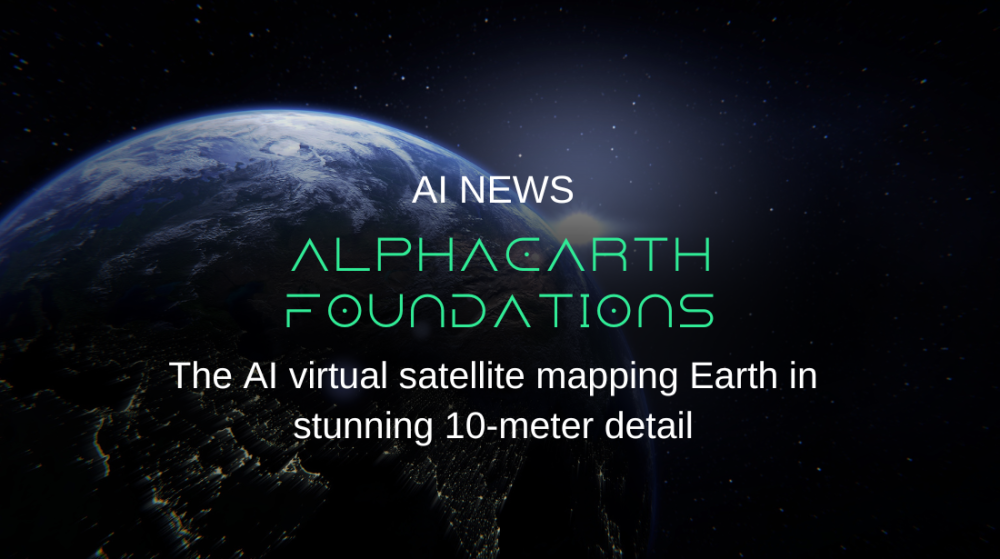AlphaEarth Foundations: The AI virtual satellite mapping Earth in stunning 10-meter detail
The world's satellites have been watching Earth for decades. Now, an AI "virtual satellite" is making sense of it al, turning a chaotic torrent of images and measurements into a single, clear picture of our changing planet.
Every day, satellites beam down images of forests, farms, cities, rivers, and coasts. The challenge isn't a lack of data, it's the overload. Different sensors, cloud cover, uneven refresh rates, and massive file sizes make it hard to see the full story.
AlphaEarth Foundations changes that. Built as a virtual satellite, this AI model fuses petabytes of Earth observation data—optical imagery, radar, 3D lidar, and climate simulations, into a unified digital "embedding." In simple terms, it summarizes the planet in crisp 10-by-10 meter squares, producing compact, consistent data that computers can analyze quickly and accurately.
AlphaEarth Foundations
Mission: Transform chaotic satellite data streams into unified AI-powered Earth intelligence system
Before: Data Fragmentation
After: Unified Intelligence
Every 10m² Earth square = 64-dimensional vector
Result: Earth Embeddings
Every 10-meter square on Earth becomes a smart, searchable data package that captures its complete environmental signature.
Key Benefits of AlphaEarth Foundations for Earth Observation and Mapping
- On-demand mapping: Scientists can generate detailed, consistent maps without waiting for a single satellite pass.
- High precision at global scale: Tracks land and coastal change over time, ideal for agriculture, deforestation monitoring, urban growth, and water resources.
- Cost and speed: Embeddings are 16x smaller than comparable AI outputs tested, cutting storage and analysis costs dramatically.
- Proven accuracy: In benchmarks, AlphaEarth Foundations achieved a 24% lower error rate than other methods tested—even with limited labeled data.
The Satellite Embedding dataset powered by AlphaEarth Foundations is now live in Google Earth Engine, with over 1.4 trillion embedding footprints per year. More than 50 organizations—including the UN Food and Agriculture Organization, Harvard Forest, Group on Earth Observations, MapBiomas, Oregon State University, the Spatial Informatics Group, and Stanford University—are already using it to build custom, high-accuracy maps.
Mapping uncharted ecosystems: The Global Ecosystems Atlas is classifying previously unmapped regions—like coastal shrublands and hyper-arid deserts—so countries can target conservation, restoration, and biodiversity protection where it counts most. "The Satellite Embedding dataset is revolutionizing our work," said Nick Murray, Director of the James Cook University Global Ecology Lab.
Monitoring change across Brazil: MapBiomas reports faster, more accurate mapping of agricultural and environmental shifts, vital for protecting biomes such as the Amazon. "We now have new options to make maps that are more accurate, precise and fast to produce," said founder Tasso Azevedo.
Seeing what satellites miss: By combining sensors across time, the model "sees through" persistent cloud cover in Ecuador to reveal evolving farm plots, resolves complex Antarctic surfaces despite irregular imaging, and exposes subtle shifts in Canadian farmland invisible to the naked eye.
How AlphaEarth Foundations works
- Multimodal fusion: Integrates optical, radar, lidar, and climate data for a complete, consistent view.
- Time-aware modeling: Learns from non-uniform observations to build a continuous picture of each location.
- Compact 64-dimensional embeddings: Each 10-meter square becomes a small, standardized vector—fast to search, map, and analyze.
Getting Started with AlphaEarth Foundations
- Explore the Satellite Embedding dataset in Google Earth Engine.
- Build custom land-use, ecosystem, and change-detection maps in hours instead of months.
- Use tutorials to accelerate projects in conservation, climate resilience, agriculture, and urban planning.
Looking ahead
Google is exploring how to pair AlphaEarth Foundations with reasoning AI agents like Gemini to deliver automated analyses and richer time-series insights as part of Google Earth AI.
Bottom line
AlphaEarth Foundations turns overwhelming satellite data into clear, actionable intelligence. From food security to forest protection, it gives scientists, governments, and communities the power to see change sooner—and act faster. Explore the embeddings in Google Earth Engine and start building maps that make a difference.





